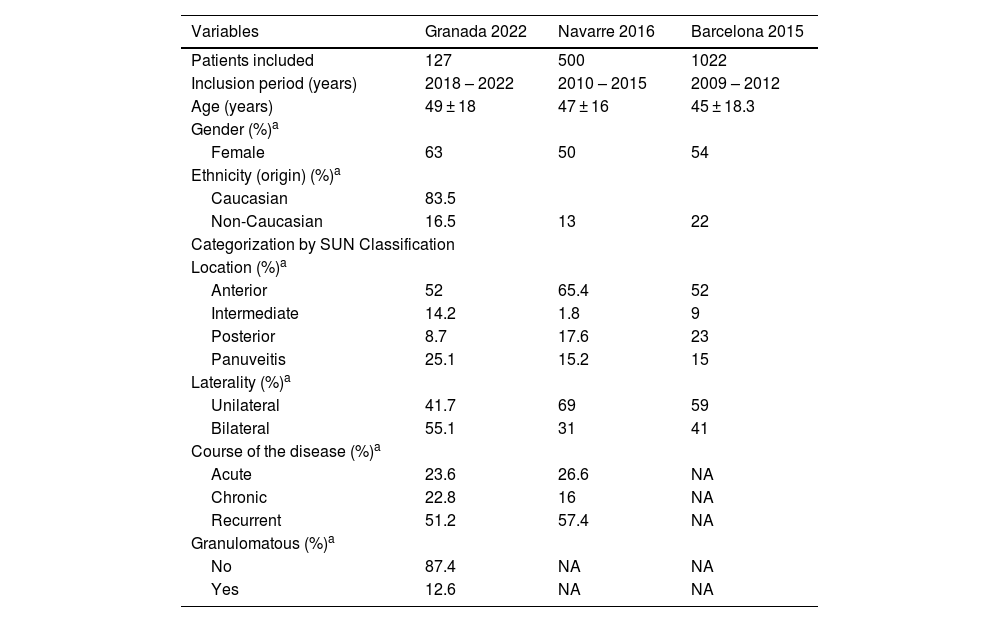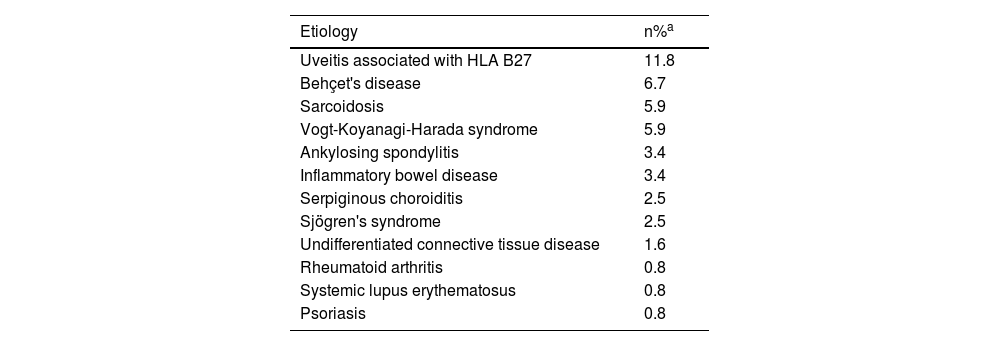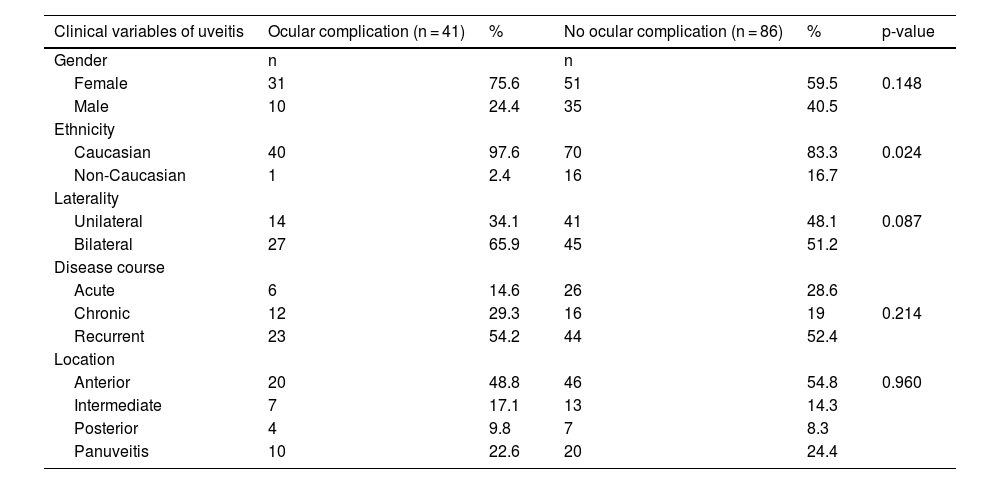To describe the characteristics of patients with uveitis and ocular complications in a tertiary hospital. As well as to determine the risk factors for the development of an ocular complication.
MethodsRetrospective study of patients with uveitis evaluated in a Uveitis Unit of the Virgen de las Nieves Hospital from January 2018 to October 2022. A descriptive and analytical study was carried out using logistic regression to know the predictive factors of a poor ocular prognosis.
ResultsA total of 127 patients were studied, of which 63% were women and 83.5% were Caucasian. The median age was 51 years IQR (15–88) years. Following the SUN classification, uveitis was predominantly bilateral (55.1%) and anterior (52%), had a recurrent evolution in 51,2% and only 12,6% were granulomatous. Of the total uveitis, 74,2% of the sample turned out to have an immune-mediated profile, although a final diagnosis was only reached in 46,1% of the patients. A total of 17,3% patients suffer from loss of vision. Visual complications in decreasing order were: posterior synechiae (15,6%), cystic macular edema (14.8%), cataracts (13,1%), glaucoma (8,2%), epiretinal membranes (4,9%) and neovascular membranes (1,7%) and retinal detachment (4%). In the bivariate analysis, ethnicity other than Caucasian was significant, p = 0,024, and a number of outbreaks greater than 2, p = 0,045. The rest of the variables analyzed were not significant. In the multivariate analysis, they were significant outbreaks OR: 1,2 CI (1,051−1,426) and ethnicity OR: 0,11 CI (0,014−0,938).
ConclusionsThe number of outbreaks and non-Caucasian race were related to a greater probability of presenting an ocular complication. An earlier and more specific diagnosis of the etiology, especially in these patients, would allow earlier treatment and improve their prognosis.
Describir las características de las uveítis inmunomediadas y sus complicaciones en un hospital de tercer nivel. Identificar los factores de riesgo para desarrollar una complicación ocular.
Material y métodosSe trata de un estudio retrospectivo de los pacientes con uveítis inmunomediadas valorados en la Unidad de Uveítis del Hospital Virgen de las Nieves de Granada entre enero 2018 y octubre 2022. Se realizó un estudio descriptivo y analítico mediante una regresión logística para conocer los factores predictivos de mal pronóstico ocular.
ResultadosSe estudiaron un total de 127 pacientes, de los cuales 63% eran mujeres y el 83,5% caucásicos. La mediana de edad fue de 51 años RIC (15–88) años. Siguiendo la clasificación SUN, las uveítis eran predominantemente bilaterales (55,1%), anteriores (52%), 51,2% presentaban un curso recurrente y el 12,6% eran granulomatosas. Se alcanzó un diagnóstico etiológico en el 46,1% de los pacientes. El 17,3% de los pacientes sufrieron pérdida de agudeza visual. Las complicaciones visuales en orden decreciente fueron: sinequias posteriores (15,6%), edema macular quístico (14,8%), cataratas (13,1%), glaucoma (8,2%), membranas epirretinanias (4,9%) y neovasculares (1,7%), desprendimiento de retina (4%). En el análisis bivariante resultaron significativas la etnia diferente a la caucásica (p = 0,024), y un número de brotes superior a 2 (p = 0,045). El resto de variables analizadas no resultaron significativas. En el análisis multivariable, fueron significativos los brotes (OR: 1,2 IC (1,051−1,426)) y la etnia diferente a la caucásica (OR: 0,11 IC (0,014−0,938)).
ConclusionesEn nuestra cohorte, el número de brotes y la raza no caucásica se relacionaron con mayor probabilidad de presentar una complicación ocular. El diagnóstico y el tratamiento eficaz del episodio agudo y de los brotes podrían permitir mejorar el pronóstico visual de los pacientes con uveítis inmunomediada.
Artículo
Comprando el artículo el PDF del mismo podrá ser descargado
Precio 19,34 €
Comprar ahora











